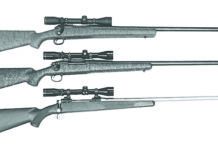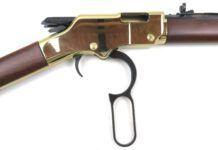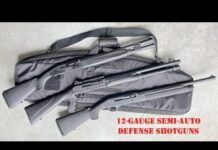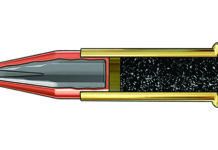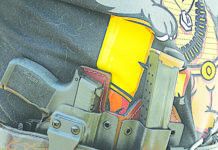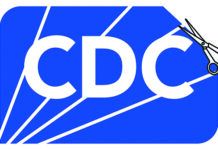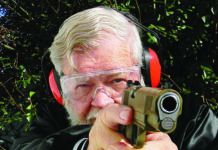We recently had the good fortune to have three interesting 9mm polymer-frame handguns come our way. Two of them are new to these pages, the Walther PPX M1 No. 2790025, $450; and the Kriss Sphinx SDP Compact, $1295. This marks the first time weve ever tested a Sphinx of any sort, and the PPX is a new model. They were joined in this shootfest by a handgun weve tested two times previously, the CZ USA CZ 75 P-07 Duty, $528, but in a new variation, the No. 91178, which has tall sights and a threaded barrel to accommodate a suppressor. Those seemingly minor changes to what has been a Grade B gun improved it in our eyes, even if we werent going to fit it with a can.
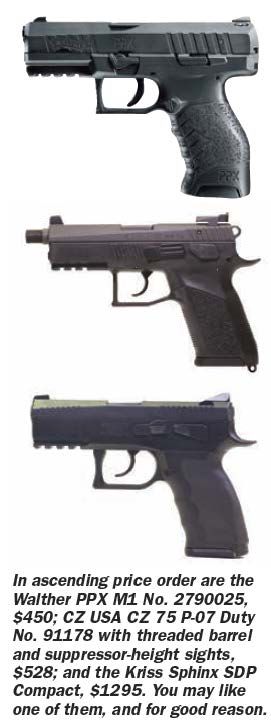
This trio had a lot in common. They were very close in overall length, if you discount the CZs longer barrel. The CZ and the Sphinx are obviously related in bloodline, with the Sphinx being fairly described as a legal, but much higher end, copy of the CZ 75. Walthers product has the most market-savvy approach, coming in many hundreds of dollars below the Swiss-made Sphinx and at least a few tens of dollars, maybe more, below the CZ. There are differences, too, with the Walther being a DAO action and the Sphinx and CZ being DA/SA, and the CZ being convertible to SA operation as well. But because of the Walthers excellent trigger, it didnt give up as much as you might think to the second-shot single actions.
But when the smoke cleared, our team said we had three above-average products that we probably would not purchase; therefore, we cant recommend that you purchase them either. You may disagree; because in the stats and descriptions below, you may see silk where we saw sows ear.
Walther PPX M1 No. 2790025 9mm Luger, $450
The PPX is a full-size polymer pistol made by Carl Walther in Germany, and imported by the Walther Arms affiliate in Fort Smith, Arkansas, as mold marks in the polymer frame attest.
Using the Gun Comparison Tool on Gun-Tests.com, we ranked 9mm pistols by barrel length, then looked at their overall lengths to see where the PPX fell. The PPX is 7.3 inches overall, compared to the OAL of the Glock 19 (6.9 inches), Sig Sauer P226 (7.0 inches), Taurus 24/7 (7.2 inches), Walther PPQ (7.25 inches), Smith & Wesson M&P 9 #209001 (7.5 inches), and Heckler & Koch P30L Variant 3 Long Slide (7.6 inches), and the Heckler & Koch USP 9 (7.7 inches), to put it in scale.
Based on our evaluation of the Walther PPQ No. 277648140 S&W in the July 2013 issue, it looks to us like the PPX is a simplified and less expensive version of the PPQ. Major differences we noticed are the double-action-only PPX is hammer fired, not striker fired. The PPX also uses a conventional button magazine release (reversible) rather than the PPQs paddle-style release. Like the PPQ, the PPX came with two Mec-Gar magazines (16 rounds in 9mm) and a hard plastic case. It lacked the PPQs loader and removable backstraps. As with the 40 S&W models, we liked the assembly and finish on the Mec-Gar mags a lot. The 9mm mags had witness holes from 4 to 16 rounds in steps of two rounds. The PPX will fire without a magazine inserted. The magazines are proprietary and come in 10-round (#2791650) and 16-round sizes (#2791714). We saw prices as high as $60 for new 16-round models.
The PPX grip has a cross-directional texture similar to its stablemates. Its depth made reaching the trigger an issue for shooters with short fingers. But the location, design, and function of the slide release was welcome. Right-handed men and women shooters alike could operate the lever slide release with the trigger-hand thumb if they chose, with most shooters requiring only a minor change in grip to reach and press the lever, allowing the slide to close. We were not comfortable working the slide release with the left hand. Lefties preferred shooting the gun to open, then switching hands to reload it and make it ready.
We want to say the gun is awkward, but thats a level too strong. But it is very top heavy. The slide weighs 17.6 ounces and the polymer frame (with magazine) comes in at 10.4 ounces, making the unloaded slide-to-frame weight ratio 62/38. A loaded magazine (19.2 ounces, which will vary according to the bullet) puts more weight in the butt, altering the starting ratio to about 47/53. As rounds leave the magazine, it doesnt take very long for the gun to feel top heavy and for the shooter to notice changing recoil characteristics.
The PPX doesnt have a manually-operated safety or decocker, which makes it blessedly simple to learn. Also helpful is a pretty good trigger, which Walther describes as a constant 6.5-pound trigger pull. An average of 10 pulls on a Lyman electronic trigger gauge (Brownells 539-000-005WB, $68) came out lighter than that, 5.6 pounds. As we noted, the starting trigger span was 2.8 inches, a hair too long for some, but most liked the short trigger travel (0.43 inch) and short trigger reset (approximately 0.1 inch). Though the PPX is officially a double-action pistol, the trigger movement cant cock the hammer, as on a double-action revolver.
Feed and function were flawless, due, in part, we believe, to the design of the PPX feed ramp and chamber face. The ramp leads to a chamber with chamfered interior edges, which allowed more than 500 rounds of ball and hollowpoint ammo to feed effortlessly. The barrel was 4.0 inches long and made of Tenifer-coated steel, with six rifling grooves and slightly under a 1:10 right-hand twist. A loaded chamber notch was cut in the top of the barrel.
Each of these guns was decidedly choosy about the ammo it preferred. The Walther favored the Federal American Eagle 147-grain FMJ Flat Points, shooting 1.6-inch five-shot average groups at 15 yards, handily beating the Sphinx (2.0 inches) and the CZ 75 P-07 (2.2 inches). But it didnt like the Winchester USA 9mm 115-grain FMJs (2.8 inches), well behind the CZ 75 P-07 (1.6 inches) and the Sphinx (2.6 inches). The PPX was also third with the Hornady Steel Match 125-grain HAP rounds, 2.5 inches, compared to 2.3 inches and 2.4 inches respectively for the CZ and the Sphinx. We thought the other two guns offered better sight pictures. The PPX showed a polymer blade with one white dot out front and two white dots on the rear low-profile polymer sight, whose base was drift adjustable. It was harder to get a reliable sight picture with it, we thought, than with the CZs tall front sight and windage-adjustable rear and the single white dot presented by the Sphinx.
Several different accessories we tried on the PPXs rail went on and off without a hitch, and we actually preferred a heavier light out front on this gun, in contrast to the heavier Sphinx. Other niceties included a lanyard loop built into the butt, front and rear slide serrations, and a grooved oversized trigger guard if you want to use it in a tactical two-handed grip. One safety issue made clear was that +P+ ammunition must not be used in the firearm.
Disassembly was a cinch. After double-checking that the gun is empty and the magazine is out, and with the barrel pointing in a safe direction, lock the slide back. Verify again that no ammunition remains in the pistol. Press the takedown catch fully downward. Gently move the slide forward and remove it from the frame. Take up spring pressure on the assembly, then remove the recoil guide-rod assembly from below the barrel. Remove the barrel from the slide.
Our Team Said: The PPX is a lot of gun for the money. For around $400 to $450, you get a good trigger, passable sights, big capacity, an accessory rail, and excellent accuracy with the right ammo.
Kriss Sphinx SDP Compact 9mm Luger, $1295
Sphinx was founded in 1876 by Josef Mller-Haiber and Jakob Schweizer as a manufacturer of screws and other steel parts. The companys production of firearms didnt begin until 1985, and Sphinxs first pistols were the ITM AT-84 and ITM AT-88, both based on the CZ 75. Now its the only company still manufacturing handguns in Switzerland. Located in Matten/Interlaken, Sphinx was purchased in November 2010 by another Swiss company, Kriss Systems SA. In the United States, Kriss USA is responsible for distribution of all Sphinx products.
Sphinx began U.S. distribution of the Sphinx SDP Compact 9mm earlier this year. To us, it looks like the Sphinx SDP Compact is an improved CZ 75, made from high-quality materials and to Swiss manufacturing standards. Its the middle child of three SDP pistols, including the Standard and Sub-Compact models. The pistols are similar in make up, outside of size. The Standard is 8.3 inches long with a 4.5-inch barrel, and the Sub-Compact is 6.55 inches long with a 3.13-inch barrel. Our test pistol, the Compact, was 7.4 inches long with a 3.7-inch barrel. In the pipeline supposedly is a Kryptonight Edition, which will have a special finish, Defiance H.A.L.O. (H3 Adaptive Luminescent Optic) green sights with combined fiber-optic and tritium technology, and a 17-round magazine.
There were several subtle aspects of the Sphinx worth noting. Like the others, it had a multi-slot Picatinny rail to accommodate tactical lights and lasers. But the Sphinx rail was made from MIL-STD 1913 aluminum, so it shouldnt wear like the polymer slots on the other guns. Most of the joints and exterior surfaces on the pistol were exceptionally well executed and looked great, and sharp edges were kept to a minimum with tapered cuts on the slide and bevels on the beavertail. Only the outside top corners of the sights would need dressing down. In the butt, theres a flared magwell for fast reloads. Out of the box, the sights were perfectly regulated and didnt require adjustment for windage or elevation. The rear serrated U-shape sight was drift-adjustable and beautifully machined. The low-profile base sat low in a dovetail and could be locked with two hex-head screws. A hex-head screw also locked down the front-sight blade in a slot.
On the inside, the guide rod included a shock absorber to mitigate the blow from the barrel. In the frame, Teflon contact surfaces eliminate the need for oiling and prevent excessive wear. All outer parts are finished with TiAlN, an acronym for titanium-aluminum-nitride. The safeties include a inertial firing pin block, hammer block, and ambidextrous manual block. The TiAlN-coated slide has deep, slanted grasping grooves that offer a great grip on the gun even with wet hands.
Common to the lines are a unique frame design with an upper frame made from aeronautic-grade aluminum with Teflon inserts and a polymer lower frame that weighs 10.6 ounces without the magazine and 13.8 ounces with an empty mag, making the dry-weight ratio 56/44 (slide weight 17.6 ounces). With 15 rounds in the magazine, the ready-to-run ratio is 43/57.
The pyramidal slide is CNC machined from high-grade steel and hand-fitted to each frame, and inspection of the metalwork revealed a tight fit and smooth surfaces throughout. We didnt see any tool marks or roughness, and the gun felt tight during regular handling. Also underneath, we noticed full-length machined guide rails and a full-length recoil buffer to ensure consistent lockup, which should translate to improved accuracy. As we noted above, however, the Compact didnt shoot the best groups with any single ammo in the test, doing its best with the Federal American Eagle 147-grain FMJ Flat Points, 2.0 inches compared to the Walther (1.6 inches). However, the Sphinx also didnt shoot the worst groups with any ammo either, so theres that.
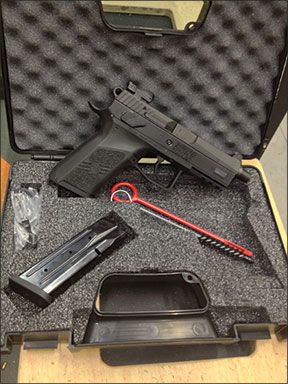
Like the double-action-only PPX, the DA/SA Sphinx is hammer fired with an ambi decocker/safety lever. We shot the Sphinx as we anticipate most shooters would, by inserting a magazine, racking the slide and loading one from the mag, then decocking the hammer to the safe half-cock position. Then we began shooting it double action and transitioned to single action. However, once decocked, the hammer has a ledge at the top allowing the shooter to manually cock the hammer for first shot single-action.
We found significant variation from the factory trigger specs, which were listed as a single-action trigger pull of 3.3 pounds and double action at 8.16 pounds. Our Lyman scale showed the average single-action pull weight as 5.5 pounds and double-action pull weight to be 11.1 pounds. With the Medium insert in place, the DA trigger span of 3.0 inches was too long for some shooters, especially when combined with the heavy DA pull. The curved trigger did help overcome the DA pull weight and long trigger travel (0.93 inch). Naturally, once the gun made it to single action, it was easier to reach (2.6-inch trigger span) and cycle (trigger reset was approximately 0.18 inch).
Installing the Small insert made the gun suitable for small-handed shooters, and the Large insert swallowed most hands. So theres enough variation provided to fit nearly anyone, in our opinion. This versatility makes it possible to vary the grip size according to conditions (winter gloves), and the oversized trigger guard accepted gloved trigger fingers comfortably.
The Sphinx also has a reversible button magazine release like the others, and it came with three Italian-made 15-round matte-blued steel magazines with removable basepads to facilitate cleaning. We liked the assembly and finish on the Sphinx-stamped mags, which had witness holes at 5, 10, and 15 rounds. The pistol will fire without a magazine inserted. Other accessories included a fitted-foam plastic pistol case, loader, and a cleaning kit. Our gun didnt come with a manual, and we were unable to find an electronic version online.
The location, design, and function of the slide release made it impossible for our shooters to operate it with one hand – it sat too far forward and required a lot of effort to push down. In particular, none of our female testers could push the slide release down without pulling back on the slide, and the 17+ pounds of slide retraction effort made the Sphinx unsuitable for them. Lefties liked being able to decock the gun from either side.
The Sphinx had full double-action operation, with its trigger movement able to cock the hammer on the first shot. Feed and function were flawless with a ramped TiAIN-coated steel barrel that was 3.7 inches long and had six right-hand grooves making 1:10 rifling twist. A lever on the right side of the barrel indicated by sight or touch the presence of a round in the chamber.
Our Team Said: This is a beautifully made gun that we would expect to improve as it broke in further. If the trigger pull had come in at the advertised weight, it could have made enough difference in accuracy to have pulled the Sphinx in front. But as a 9mm carry or car or house gun, the Sphinxs heavy double-action pull and the very tight slide and control operation, as tested, give us pause.
CZ USA CZ 75 P-07 Duty No. 91178 9mm Luger, $528
CZ products are imported exclusively by CZ-USA, a wholly owned subsidiary of the parent company, Ceska Zbrojovka a.s. Uhersky Brod, (CZUB) of the Czech Republic. CZ firearms have been available through normal channels in the US since 1991, through such importers/distributors as Bauska, Action Arms, Magnum Research. In 1997 CZUB opened the CZ-USA headquarters and warehouse facility in Oakhurst, California. This operation was moved to Kansas City in January 1998; currently, all distribution, warranty work, and repair work is located in the Kansas City, Kansas location, along with a comprehensive parts department.
Two new versions of the CZ 75 P-07 Duty have come available since our last test of the line in October 2010. An OD Green version debuted in April 2012, and a month later, our test gun, the No. 91178, came fitted with a threaded barrel that made it suppressor ready. With its 1/2×28 threaded muzzle, this version of the P-07 Duty accepts most suppressors made for the U.S. market. Along with this, the sights on this variation are higher than normal so they will clear 1-inch-diameter suppressors.
With a can of that size aboard, we noted the LPA adjustable rear sight and 0.314-inch-tall front blade provided a good sight picture and allowed us to shoot with both eyes open. As befits a pistol with the word Duty in its name, the 91178 also has a lanyard loop on the butt.
The pistols polymer frame was stippled on the sides of the grip and ridged on the front strap and back straps. We noted it has the basic grip shape (circumference, angle, etc.) of the CZ 75, thus the name. Compared side by side with the larger pistol, we noted the polymer frame eliminated the need for the grip panels that are used on most steel and alloy-framed autos. This created a little more space that was used to increase the magazine capacity by 2 rounds. The flush-fitting magazine of the P-07 Duty holds the same number of rounds that the full-sized versions of the CZ 75 do in both 9mm Luger and 40 S&W.
As we noted in our first test of this handgun in the August 2009 issue, the P-07 shipped with an optional set of ambidextrous thumb levers. When swapped out with the decocker levers, the P-07 could be fired single-action with a thumb-operated safety. That test focused on the single-action capability of the P-07, so for this test we left the decocker on and shot the gun as a double-action first shot. In single-action mode, the P-07 can still be fired DA/SA, but without a decocker, the hammer can only be lowered manually.
The presence of the threaded barrel, a seemingly innocuous change, actually caused quite a few variations. The overall length of this model was 8.25 inches, not quite an inch longer than the No. 91186 tested in 2010. Most of the length differences came from the barrels, 4.5 inches today versus 3.8 inches then. Elsewhere, this test gun was 5.5 inches tall, 0.4 inches taller than the 91186 because of the presence of the suppressor-clearing sights. This gun was also heavier (28.8 ounces versus 25.2 ounces) and had a longer sight radius (5.75 inches versus 5.1 inches),
During handling and break in, we noted the effective texturing on the grip panels and straps. The patch of checkering near the slide lock worked as an index point for the trigger finger out of the trigger guard. Used like that, the patch made some sense. The pistols frame felt comfortable to our shooters, a testament to its predecessors shape, we believe. The long trigger span in double-action set was a problem for our female shooters and some of our male shooters, who had trouble reaching the trigger-finger pad to the front face of the trigger.
The stout double-action trigger pull weight, 9.4 pounds, was another problem for our female shooters, as was the heavy slide spring. It took more than 15 pounds of rearward pressure to rack the slide, too much for three female shooters to operate comfortably. Lefties liked having a decocker on each side, and the grips offered a neutral feel. Racking the slide was no problem for southpaws either. They needed to only slightly reposition the left-hand grip to release the slide lever with the shooting finger, while the right hand pulled the slide back.
During break-in and familiarization, the pistol digested 325 rounds of ball ammunition without complaint. During this time, we noted some magazines did not drop free, but instead had to be pulled free. We understand why some agencies dont want the officer to drop magazines free, but we prefer it. In reality, how the mags ejected depended on how we pressed the release. If the shooter had a short thumb, he or she could reach the back of the release button and partially eject the magazine. If the shooter could reach the front of the button, the mag would shoot out.
The trigger guard was square at the front, and it was grooved for grip in case you grip the gun with the weak-hand index finger extended and wrapped around the trigger guard. The web of the shooters strong hand was buried deep into a recess at the top of the grip under a short polymer beavertail.
The decocker is a handy design that falls under the thumb easily. The frame features a light rail. The hooked trigger guard appears odd, but it worked well with a combat light butted against it.
The slide rides low inside the frame. This allows a lower bore axis and increases accuracy potential by giving the long bearing surfaces more contact with the frame. There are no forward cocking serrations, making the slide a little more difficult to grasp and rack than the others.
Trigger action was smooth, requiring 9.4 pounds of compression in double action. The new Omega action is smoother than the original CZ 75, but feels different.
There is a good bit of take up in the single-action trigger press. Once the slack is taken, the trigger breaks cleanly enough at 3.8 pounds.
The hood of the barrel locks into the slide like a Glock or Sig and is unlocked via a camming surface below the chamber that mates with a camming surface on the locking block in the frame. Removing the top end of the P-07 required pulling the slide back about one-quarter inch and removing the slide-stop pin. The tip of the slide-stop pin was flush with the right side of the frame and beveled to accept a small punch or the corner of the magazine base pad, as was recommended by the owners manual. The advantage of a flush-set pin is to avoid any possibility of it being pushed inward accidentally and possibly stalling the action. With the safety off and hammer in the half-cock position, the slide can now be removed. Beneath the barrel was a flat wound recoil spring that was long and strong, making reinstallation challenging. This pistol and the similar Sphinx were more difficult to break down than the Walther.
We fired the pistol on combat courses at 5, 7, and 10 yards. There were no failures to feed, chamber, fire or eject. Felt recoil was noticeably greater than the Sphinx, but muzzle flip was less about the same due to the low bore axis. And both the CZ and Sphinx develop less flip than the PPX, our shooters said. We tried several suppressors on the gun and liked how the high adjustable sights allowed the shooter to see over the can without any equipment changes. Installation and removal of all of the suppressors was smooth and easy. Adding weight to the front of the gun also tamed some of its recoil characteristics, though the heavier nose also made it slower to target. And with a light and suppressor, the front of the gun gets pretty crowded. For home use, we can see pairing the Duty with a suppressor. For car carry, where its legal, the long OAL of the pistol and suppressor make it unwieldy in tight spaces. But even without the suppressor, the tall sights were universally praised.
Our Team Said: Changes made to the P-07 Duty No. 91178 to make it suppressor-ready are worthwhile. Adding a suppressor to the threaded barrel was a cinch, and the raised adjustable sights were an improvement over previous models weve tested.
Written and photographed by Gun Tests staff, using evaluations from Gun Tests team testers.







